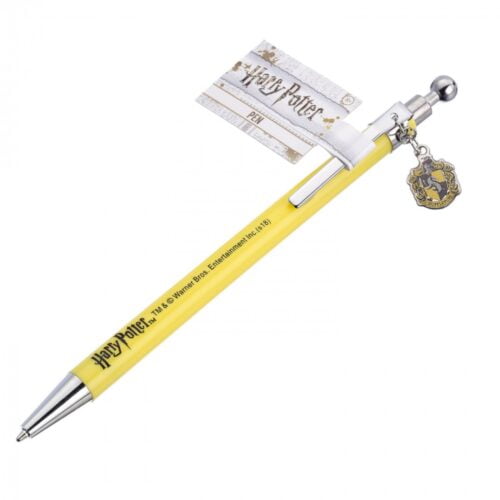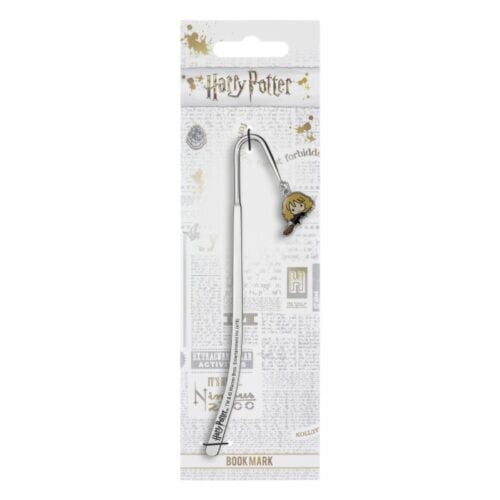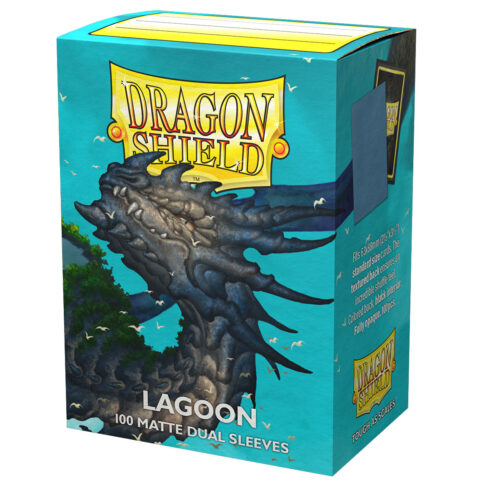 Dragon Shield Dual Matte sleeves. Clear front and a textured matte back. Fully opaque sleeves with a black interior, an elegant backdrop for black bordered cards. The sturdy cardboard box fits 75+ single sleeved cards or 65+ double sleeved cards. Every box has a label on the top for personalization.
Dragon Shield Dual Matte sleeves. Clear front and a textured matte back. Fully opaque sleeves with a black interior, an elegant backdrop for black bordered cards. The sturdy cardboard box fits 75+ single sleeved cards or 65+ double sleeved cards. Every box has a label on the top for personalization.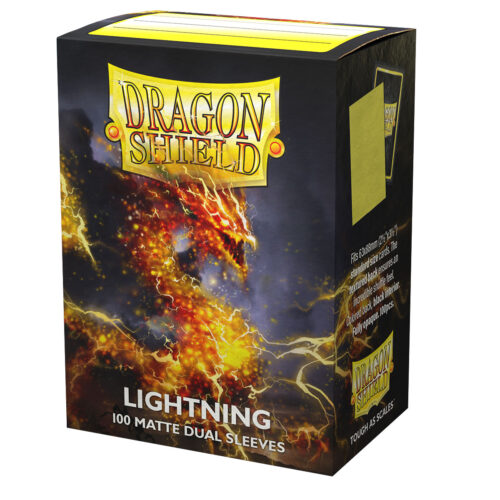 Dragon Shield Dual Matte sleeves. Clear front and a textured matte back. Fully opaque sleeves with a black interior, an elegant backdrop for black bordered cards. The sturdy cardboard box fits 75+ single sleeved cards or 65+ double sleeved cards. Every box has a label on the top for personalization.
Dragon Shield Dual Matte sleeves. Clear front and a textured matte back. Fully opaque sleeves with a black interior, an elegant backdrop for black bordered cards. The sturdy cardboard box fits 75+ single sleeved cards or 65+ double sleeved cards. Every box has a label on the top for personalization.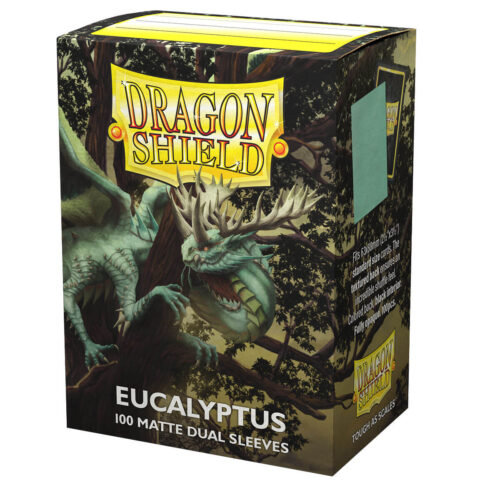 Dragon Shield Dual Matte sleeves. Clear front and a textured matte back. Fully opaque sleeves with a black interior, an elegant backdrop for black bordered cards. The sturdy cardboard box fits 75+ single sleeved cards or 65+ double sleeved cards. Every box has a label on the top for personalization.
Dragon Shield Dual Matte sleeves. Clear front and a textured matte back. Fully opaque sleeves with a black interior, an elegant backdrop for black bordered cards. The sturdy cardboard box fits 75+ single sleeved cards or 65+ double sleeved cards. Every box has a label on the top for personalization. 24 sideloadded card pockets per page, which is ideal for displaying playsets of 4 cards. Our pocket pages are made with a special technique in which the clear polypropylene is folded around the right edge of the page, making these pages uniquely soft to touch and pleasant to flip through. The professor's #1 pick for storing sleeved cards. These pages feature ultra clear pockets on a black textured backing.
24 sideloadded card pockets per page, which is ideal for displaying playsets of 4 cards. Our pocket pages are made with a special technique in which the clear polypropylene is folded around the right edge of the page, making these pages uniquely soft to touch and pleasant to flip through. The professor's #1 pick for storing sleeved cards. These pages feature ultra clear pockets on a black textured backing.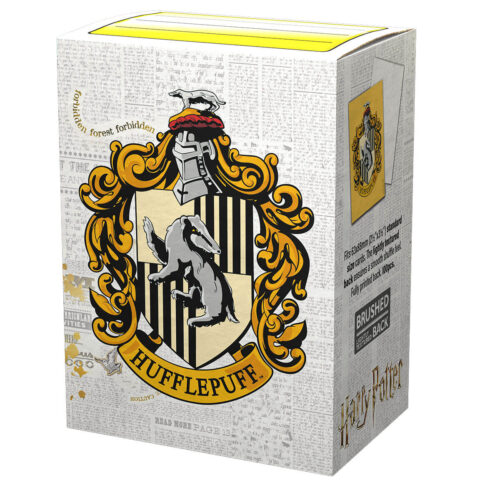 Ah... hmmm... loyal and patient... hmmm... ok. Hufflepuff! Represent your Hogwarts house with these Brushed Art Sleeves. Clear front and Brushed Art back with Hufflepuff house crest. Harry Potter licensed sleeves are made of tough, PVC-free polypropylene. The artwork is printed directly on the sleeves and doesn?t peel or split. The sturdy cardboard box fits 75+ single sleeved cards or 65+ double sleeved cards. Every box has a label at the top of the box for personalization. Like these sleeves? Check out our other Harry Potter licensed products.
Ah... hmmm... loyal and patient... hmmm... ok. Hufflepuff! Represent your Hogwarts house with these Brushed Art Sleeves. Clear front and Brushed Art back with Hufflepuff house crest. Harry Potter licensed sleeves are made of tough, PVC-free polypropylene. The artwork is printed directly on the sleeves and doesn?t peel or split. The sturdy cardboard box fits 75+ single sleeved cards or 65+ double sleeved cards. Every box has a label at the top of the box for personalization. Like these sleeves? Check out our other Harry Potter licensed products.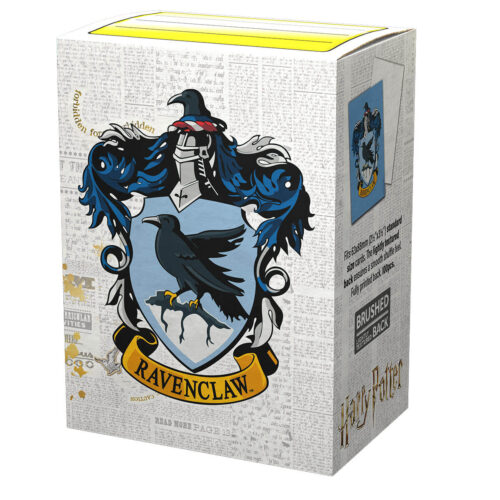 Ahhhh... witty... and a thirst for knowledge... ok... I know. Ravenclaw! Represent your Hogwarts house with these Brushed Art Sleeves. Clear front and Brushed Art back with Ravenclaw house crest. Harry Potter licensed sleeves are made of tough, PVC-free polypropylene. The artwork is printed directly on the sleeves and doesn?t peel or split. The sturdy cardboard box fits 75+ single sleeved cards or 65+ double sleeved cards. Every box has a label at the top of the box for personalization. Like these sleeves? Check out our other Harry Potter licensed products.
Ahhhh... witty... and a thirst for knowledge... ok... I know. Ravenclaw! Represent your Hogwarts house with these Brushed Art Sleeves. Clear front and Brushed Art back with Ravenclaw house crest. Harry Potter licensed sleeves are made of tough, PVC-free polypropylene. The artwork is printed directly on the sleeves and doesn?t peel or split. The sturdy cardboard box fits 75+ single sleeved cards or 65+ double sleeved cards. Every box has a label at the top of the box for personalization. Like these sleeves? Check out our other Harry Potter licensed products. Let?s see... hmmm... brave and chivalrous... I know. Gryffindor! Represent your Hogwarts house with these Brushed Art Sleeves. Clear front and Brushed Art back with Gryffindor house crest. Harry Potter licensed sleeves are made of tough, PVC-free polypropylene. The artwork is printed directly on the sleeves and doesn?t peel or split. The sturdy cardboard box fits 75+ single sleeved cards or 65+ double sleeved cards. Every box has a label at the top of the box for personalization. Like these sleeves? Check out our other Harry Potter licensed products.
Let?s see... hmmm... brave and chivalrous... I know. Gryffindor! Represent your Hogwarts house with these Brushed Art Sleeves. Clear front and Brushed Art back with Gryffindor house crest. Harry Potter licensed sleeves are made of tough, PVC-free polypropylene. The artwork is printed directly on the sleeves and doesn?t peel or split. The sturdy cardboard box fits 75+ single sleeved cards or 65+ double sleeved cards. Every box has a label at the top of the box for personalization. Like these sleeves? Check out our other Harry Potter licensed products. Hmmmmm... ambitious and resourceful... right then... I know. Slytherin! Represent your Hogwarts house with these Brushed Art Sleeves. Clear front and Brushed Art back with Slytherin house crest. Harry Potter licensed sleeves are made of tough, PVC-free polypropylene. The artwork is printed directly on the sleeves and doesn?t peel or split. The sturdy cardboard box fits 75+ single sleeved cards or 65+ double sleeved cards. Every box has a label at the top of the box for personalization. Like these sleeves? Check out our other Harry Potter licensed products.
Hmmmmm... ambitious and resourceful... right then... I know. Slytherin! Represent your Hogwarts house with these Brushed Art Sleeves. Clear front and Brushed Art back with Slytherin house crest. Harry Potter licensed sleeves are made of tough, PVC-free polypropylene. The artwork is printed directly on the sleeves and doesn?t peel or split. The sturdy cardboard box fits 75+ single sleeved cards or 65+ double sleeved cards. Every box has a label at the top of the box for personalization. Like these sleeves? Check out our other Harry Potter licensed products. The party game That's a Question!, takes the familiar format of challenging others with questions, then voting on what they'll say. In more detail, each player has a hand of hexagonal cards, with words or phrases in three color blocks on the card. On a turn, you choose a player that has a token in front of them, take that token, then present them with a question by choosing one of the three question prompts (which are all color-coded), then choosing two cards from your hand and adding the properly-colored section of those cards to the question. A sample question: "What would you miss more if it ceases to exist: Facebook or doors?" That player secretly votes on A or B, while everyone else but the questioner secretly votes A or B depending on how they think the person will answer; a voter can optionally add their 3x scoring token to their vote. Once everyone votes, you reveal the tiles. Everyone who voted correctly moves ahead one or three spaces on the scoring track, and the questioner moves ahead one space for each person who voted incorrectly. If you pass a certain space on the scoring track, you retrieve your 3x token (if you've used it). Since you can ask a question only of those with a token in front of them, everyone is asked roughly the same number of questions, and whoever has the most points after a certain number of rounds wins.
The party game That's a Question!, takes the familiar format of challenging others with questions, then voting on what they'll say. In more detail, each player has a hand of hexagonal cards, with words or phrases in three color blocks on the card. On a turn, you choose a player that has a token in front of them, take that token, then present them with a question by choosing one of the three question prompts (which are all color-coded), then choosing two cards from your hand and adding the properly-colored section of those cards to the question. A sample question: "What would you miss more if it ceases to exist: Facebook or doors?" That player secretly votes on A or B, while everyone else but the questioner secretly votes A or B depending on how they think the person will answer; a voter can optionally add their 3x scoring token to their vote. Once everyone votes, you reveal the tiles. Everyone who voted correctly moves ahead one or three spaces on the scoring track, and the questioner moves ahead one space for each person who voted incorrectly. If you pass a certain space on the scoring track, you retrieve your 3x token (if you've used it). Since you can ask a question only of those with a token in front of them, everyone is asked roughly the same number of questions, and whoever has the most points after a certain number of rounds wins. Is she drawing an elk or a moose? Is he drawing a pegasus or a unicorn? These are the types of questions you will probably be asking yourself during a game of Pictomania! There's no time to draw a complex masterpiece in Pictomania, the drawing game in which everybody draws and everybody guesses ? all at the same time! Players sketch the essence of the word with a few quick lines and try to guess the others' drawings while there's still time. This second edition of Pictomania features revised word cards with a brand new look. One big change for this edition compared to the base game is that only three word cards are in play no matter the player count, allowing you to jump into each round more quickly since you don't have to read as many words to guess who might be drawing what.
Is she drawing an elk or a moose? Is he drawing a pegasus or a unicorn? These are the types of questions you will probably be asking yourself during a game of Pictomania! There's no time to draw a complex masterpiece in Pictomania, the drawing game in which everybody draws and everybody guesses ? all at the same time! Players sketch the essence of the word with a few quick lines and try to guess the others' drawings while there's still time. This second edition of Pictomania features revised word cards with a brand new look. One big change for this edition compared to the base game is that only three word cards are in play no matter the player count, allowing you to jump into each round more quickly since you don't have to read as many words to guess who might be drawing what.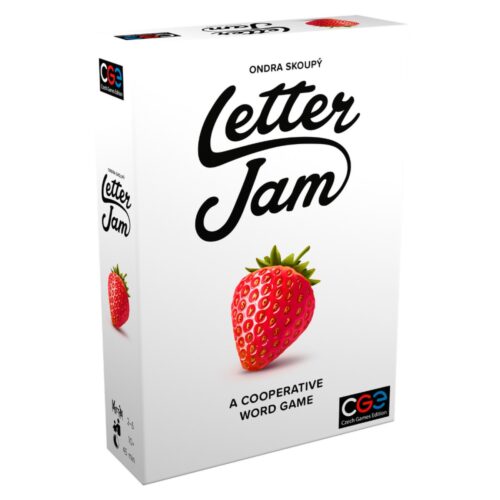 Letter Jam is a 2-6 player cooperative word game where players assist each other in composing meaningful words from letters around the table. The trick is holding the letter card so that it?s only visible to other players and not to you. At the start of the game, each player receives a set of face-down letter cards that can be arranged to form an existing word. The setup can be prepared by using a special card scanning app, or by players selecting words for each other. Each player then puts their first card in their stand facing the other players without looking at it, and the game begins. The game is played in turns. Each turn, players simultaneously search other players? letters to see what words they can spell out (telling the others the length of the word they can make up). The player who offers the longest word can then be chosen as the clue giver. The clue giver spells out their clue by putting numbered tokens in front of the other players. Number one goes to the player whose letter comes first in the clue, number two to the second letter etc. They can always use a wild card which can be any letter, but they cannot tell others which letter it represents. Each player with a numbered token (or tokens) in front of them then tries to figure out what their letter is. If they do, they place the card face down before revealing the next letter. At the end of the game, players can then rearrange the cards to try to form an existing word. All players then reveal their cards to see if they were successful or not. The more players who have an existing word in front of them, the bigger their common success.
Letter Jam is a 2-6 player cooperative word game where players assist each other in composing meaningful words from letters around the table. The trick is holding the letter card so that it?s only visible to other players and not to you. At the start of the game, each player receives a set of face-down letter cards that can be arranged to form an existing word. The setup can be prepared by using a special card scanning app, or by players selecting words for each other. Each player then puts their first card in their stand facing the other players without looking at it, and the game begins. The game is played in turns. Each turn, players simultaneously search other players? letters to see what words they can spell out (telling the others the length of the word they can make up). The player who offers the longest word can then be chosen as the clue giver. The clue giver spells out their clue by putting numbered tokens in front of the other players. Number one goes to the player whose letter comes first in the clue, number two to the second letter etc. They can always use a wild card which can be any letter, but they cannot tell others which letter it represents. Each player with a numbered token (or tokens) in front of them then tries to figure out what their letter is. If they do, they place the card face down before revealing the next letter. At the end of the game, players can then rearrange the cards to try to form an existing word. All players then reveal their cards to see if they were successful or not. The more players who have an existing word in front of them, the bigger their common success.


